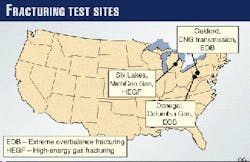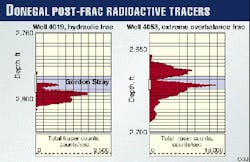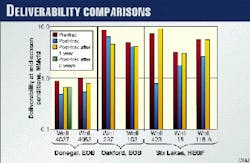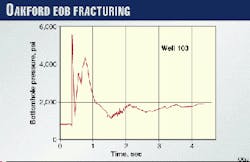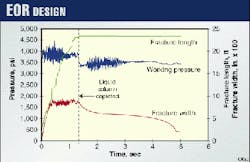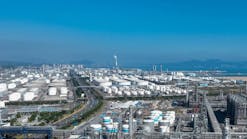This third of a four-part series (OGJ, Nov. 15, 1999, p. 43, Part 1; Nov. 29, p. 58, Part 2) discusses these two fracturing methods.
At first glance, the EOB method appears an operationally simple and inexpensive option compared to hydraulic fracturing. Optimal design requirements, as well as field experience, suggests otherwise.
To be successful consistently, EOB treatments must be carefully designed with advanced computer models, the wellbore must be in good mechanical condition, and the operational procedures must be kept simple. Even when these conditions are met, the best achievable result may only be a short, bi-winged fracture.
On the other hand, HEGF fracturing is operationally simple (similar to perforating), inexpensive, and does not require a wellbore in flawless condition. Furthermore, the downhole pressures that can be achieved virtually guarantee the creation of multiple fractures extending from the wellbore.
The technique, however, is not well suited to overcoming certain types of recurring damage mechanisms, such as salt deposition as was the case in the Six Lakes field.
It is interesting to note that one may not have to choose between one technique or the other because the two technologies appear to be merging to provide an entirely new spectrum of performance-enhancing designs. As such, pulse-fracturing techniques still hold considerable promise for gas storage.
Pulse fracturing
Pulse fracturing oil and gas wells involves the extremely rapid introduction of high-pressure fluids to the formation face, thus creating a series of fractures. Depending upon the peak pressures reached and the mechanical properties and stress conditions of the reservoir rock, multiple fracture sets can be created that radiate outward from the wellbore.
But created fracture lengths are unlikely to exceed 25 ft because of the limited volumes of high-pressure fluid that can be brought to bear on the formation in a nearly instantaneous fashion.
At least two pulse-fracturing techniques are in use: extreme overbalance (EOB) and high-energy gas fracturing (HEGF).
In EOB fracturing, the gas, usually nitrogen, is pumped into the well over liquid until the desired pressure is achieved, about 11/2 times the expected fracture gradient. In new wells, perforating provides the instantaneous exposure of the formation to pressurized fluid. But in wells with existing perforations, a packer and rupture disk have to be used.
In either case, a liquid column is usually positioned across and above the perforations to act as a viscous fracturing fluid. The EOB method is usually constrained by wellhead pressure or other wellbore configuration limitations. These considerations also constrain the maximum pressures, resulting in the likely creation of a single bi-winged fracture and not a radial fracture pattern.
The HEGF process involves the use of electric line or tubing-conveyed tools to ignite a propellant charge, similar in composition to solid rocket fuel, which is positioned across the formation. The propellant burns within a few milliseconds and creates a high-pressure gas pulse.
The propellants in a typical tool burn to form mainly carbon dioxide and some water. Relatively little fluids are involved, which limits the extent of fracturing both radially and vertically.
EOB and HEGF both have the following two advantages:
- Creation of an effective stimulation in the near-wellbore region, which is ideal for bypassing formation damage in high-permeability reservoirs.
- Limitation of fracture extent, which reduces the risk of uncontrolled and undesirable upward or downward fracture growth.
Fig. 1 shows the gas storage fields in which these methods have been tested under a DOE-sponsored research and development project. The study included one of the first gas-storage applications of EOB and the first HEGF in gas storage wells.
The high-speed bottomhole pressure records collected during these jobs were also firsts for gas storage. These data have provided critical feedback on the design and effectiveness of these techniques.
To enable design and evaluation of EOB jobs with confidence, the study identified a critical need for analytical tools. This led to modifying a dynamic formation fracturing and wellbore simulator specifically to handle EOB designs. This new work triggered a separate DOE research program for developing the simulator to a commercial level.
Dynamic fracture simulator runs revealed a complex interaction of several variables important for good EOB design. The number of open perforations, mass and viscosity of the fracturing-fluid liquid slug, wellbore tubular diameter, and working pressure all must be balanced for an effective EOB treatment.
The study showed that general assumptions about achieving a specified fracture gradient and continued pumping after the job were inadequate for effectively fracturing the reservoir.
EOB fracturing
Two operators offered test sites for the extreme overbalance technique: Donegal storage field, Washington County, Pa., operated by Columbia Gas Transmission Corp., Charleston, W. Va., and Oakford storage field, Westmoreland County, Pa., operated by CNG Transmission Corp., Charleston, W. Va.,
Donegal has proven to be a challenge for deliverability improvement. The operator previously reperforated the storage zone without success. Traditional hydraulic and tip-screenout fracturing efforts had also limited benefits.
The hard, Devonian Gordon Stray sand is thin, only 10 ft in most places, and combined with a 2,600-ft depth and high fracture gradient conspired to induce horizontal fractures at the formation boundaries, as indicated by Well 4019 post-TSO radioactive tracer log (Fig. 2). Thus, the need was apparent to try the higher energy, more focused EOB stimulation technique.
In summer 1996, two wells were stimulated as part of Columbia's four-well EOB program. At the time, the only design guidelines for EOB fracturing were static pressure calculations for the wellbore at the start of the job and rules of thumb for estimating the necessary fracture gradient to perform the job. All these jobs applied pressure to the entire casing.
While this design provided adequate treatment volumes, it also critically limited working pressure. Of the four treatments, one fractured the Gordon Stray, one failed to fracture the formation (Well 4037), one well was fractured out of the zone by continued pumping after the job, and one job failed for mechanical reasons.
Well 4053 radioactive tracer log shows a successful EOB fracture (Fig. 2, right side). Note that despite a tendency for horizontally orientated hydraulic-induced fractures, vertical fractures appear to have been successfully created with the EOB process. Nevertheless, as with the other previous deliverability improvement techniques tried at Donegal, deliverability was not improved for Well 4053 or its companion, Well 4037 (Fig. 3).
The Oakford field provided good candidate wells for fracturing. Test well permeabilities ranged from 300 to 720 md with high skin values ranging from +28 to +59. Given the earlier experience at Donegal, job design at Oakford had a high priority.
The dynamic wellbore and formation fracture simulator was used for job design to reconcile several considerations. Using a high-pressure workstring protected older, low-working-pressure well equipment.
The cased-hole completions were to be reperforated as part of the stimulation, and gelled water was to be used as the fracturing fluid driven by the high-pressure nitrogen. Special high speed, shockproof bottomhole pressure recorders were included.
The jobs were performed in September 1997. The first well, Well 237, failed to achieve formation breakdown. Apparently, the gelled fracturing fluid leaked into the formation during a delay prior to treatment initiation.
When the perforating gun fired in the absence of fluid, it expanded to such a degree that it acted as a downhole choke and prevented the rapid application of pressure to the formation.
Stimulation of the second well, Well 103, avoided this problem and was executed as planned. Bottomhole pressure analysis indicated the creation of a bi-wing fracture with a 15 ft half-length. Fig. 4 shows the bottomhole pressure record, the first pressure record for an EOB job recovered from any well.
An important observation about these data is that the EOB job was effectively over after 1 sec of elapsed time. Hence, the continued pumping of nitrogen after the initial surge, a common practice for EOB treatments, would be of little benefit.
Unfortunately, mechanical difficulty in retrieving equipment from the well after the job resulted in well killing and fishing operations that probably reversed any benefits realized from the fracturing. As a result, deliverability for these two wells was not improved (Fig. 3), although considerable advancements in EOB technology were achieved.
Propellant fracturing
To test high-energy propellant fracturing, DOE selected the Six Lakes storage field, Mecosta Co., Mich., operated by Michigan Consolidated Gas Co., Detroit, Mich. Three wells were fractured in August 1998.
The storage horizon at Six Lakes is the Mississippian age Michigan Stray sandstone, at a relatively shallow 1,250 ft average depth. The sand is massive with storage gas occupying the upper portion and mobile water below. Testing of candidate wells again revealed high permeability, 225-470 md, and high skin factors, +28 to +75.
Damage at Six Lakes is primarily caused by salt deposition over the openhole interval. Freshwater washes with coiled tubing effectively remove the damage but do not stimulate the wells.
The proximity of bottom water prevents traditional hydraulic fracturing techniques. But the focused application of propellant could create multiple fractures with limited extension in the gas zone.
A dynamic pressure wellbore and fracture simulator aided the job design. Besides the creation of fractures, the major design consideration was to ensure that a large pressure pulse would not be transmitted to surface and damage wellhead equipment.
The stimulations successfully created multiple fractures with limited height, confirmed by pre and post-frac video logging. In some cases, a single fracture also was observed below the storage horizon, which may have affected the results.
The three stimulations obtained high-speed bottomhole pressure recordings (Fig. 5a). Propellant ignition generated a maximum pressure of about 15,000 psi for 2 msec. Fig. 5b shows the surface pressure record from another well that indicates essentially no observed pressure response at the surface.
Even with the apparently successful execution of the three propellant stimulations, deliverability improvement, to date, has been moderate on average. As shown in Fig. 3, all three wells had reduced deliverability immediately following the treatments but appeared to clean up after 1 year.
Unlike tip-screenout fracturing, improved results from propellant stimulation were expected to be immediate. The reason for the delayed response may be related to having downhole a 10-ppg brine cushion, which may take time to clean up. Anecdotal results from propellant stimulations performed in Canada suggest that fluid loss to the formation prior to propellant stimulation leads to poorer performing wells.
Analytic tools
The need for analytical tools applicable to EOB fracturing was identified as critical to enable design and evaluation of these jobs with confidence. This led to modifications to a dynamic formation fracturing and wellbore simulator to specifically handle EOB designs.
Fig. 6 shows an example of a simulated EOB design. This new work has triggered a separate DOE research program to enhance the simulator to a commercial level.
The dynamic fracture simulator revealed a complex interaction of several variables important to good EOB design as follows:
- Number of open perforations.
- Mass and viscosity of the liquid slug used as fracturing fluid.
- Wellbore tubular diameters and working pressure that are all balanced to achieve the full effect of an EOB treatment.
These jobs showed that the previous general assumptions about achieving a specified fracture gradient and continued pumping after were inadequate for effectively fracturing the reservoir.
The Authors
John F. Schatz is a geophysicist at his firm, John F. Schatz Research & Consulting Inc. San Diego, Calif. He has 27 years of professional experience in research and development, applications, and management that include data analysis, modeling, and software development in rock mechanics and related disciplines.
His recent work includes dynamic fracturing design using a unique computer model and the scaling of rock mechanical properties for size and frequency.
Robert M. Bomar is senior field geologist at Michigan Consolidated Gas Co.'s Six Lakes gas storage field. He previously worked for Core Laboratories Inc. Currently he is involved in numerous gas reserve and gas storage evaluation projects.
Edward Dereniewski is a senior petroleum engineer at Michigan Consolidated Gas Co., Detroit, Mich. He has extensive experience in well test analysis and well remediation and has been involved with the development of four storage fields. Dereniewski holds a BS in chemical engineering from Wayne State University.
Timothy D. Maddox is reservoir supervisor, gas storage department. Columbia Gas Transmission Co., Charleston, W.Va. Maddox holds a BS in geology from Bowling Green State University and a BS in petroleum engineering from Marietta College.
